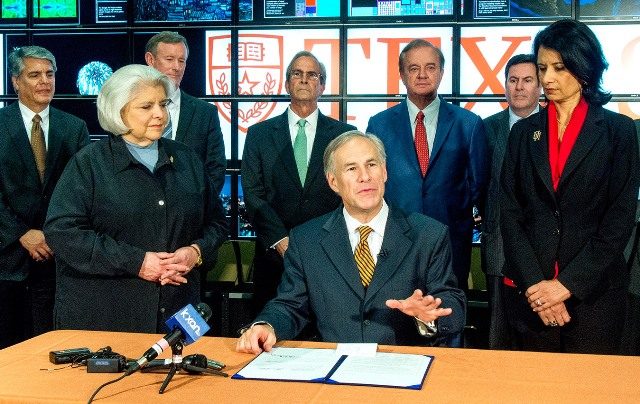Ten top scholars will sign onto prestigious posts at Texas universities through the Governor’s University Research Initiative (GURI).
“Texas is the home of innovation, and with the addition of these world-class scholars to our university faculties, we will continue to lead the nation in cutting-edge research,” said Abbott on July 14.
The program earmarks up to $400 million to fund new talent that will allow Texas universities to attract Nobel Prize laureates and other “best in their field” researchers. Gov. Greg Abbott believes that the initiative will “fuel future growth for generations to come.” This inaugural round of GURI recipients will fill posts at Texas A&M, the University of Houston, and the flagship Austin campus of the University of Texas, funded by more than $34 million in one-to-one matching grants from each of these universities.
In 2015, Abbott appointed nine members to an advisory board following the passage of SB 632 and HB 26, which jointly implemented the higher education research emergency item by eliminating the Emergency Technology Fund (ETF). GURI utilizes a portion of the ETF’s un-expended balance to provide matching funds to help state colleges and universities recruit prestigious, nationally-recognized researchers to their faculty. The other ETF funds went to the Texas Enterprise Fund (TEF), used to attract businesses into the state.
Texas A&M topped the list, receiving $20 million in GURI grants to bring five innovators to the campus in September. The University of Houston snagged three top energy researchers funded by $8.5 million. UT-Austin recruited two scholars in fields of chemical engineering and molecular biosciences with $5 million.
The 10 researchers are members of various prestigious organizations including the Royal Society of the United Kingdom, the National Institutes of Health, the National Academy of Engineering, and the National Academy of Sciences. A news release from the Governor’s office lists comprehensive resume details and individual grant dollars per new hire. Below are highlights.
Headed to Texas A&M:
Dr. George M. Pharr, IV, a National Academy of Engineering member whose research focuses on the creation and testing of nanomaterials, comes from the University of Tennessee. Beginning Fall 2017, he will teach in the Material Science and Engineering Department on both undergraduate and graduate levels.
Dr. Girish Saran Argawal is a member of the Royal Society of the United Kingdom and a Regents professor at Oklahoma State University. His research centers on theoretical quantum optics and developing applications for the technology. In Spring 2017, he will teach a course on Spectroscopy and work with graduate students.
Dr. Leif Anderson, affiliated with the National Academy of Sciences, will study the genetics of domesticate animals and teach at the College of Veterinary Medicine and Biomedical Sciences starting in September.
Dr. Richard B. Miles, a National Academy member, will head a new Center of Excellence in Interdisciplinary Optical and Laser Detection Systems for National Security and Safety and serve as faculty in the Aerospace Engineering and Mechanical Engineering departments beginning February 2017. Currently, he is a Senior Scholar at Princeton University.
Dr. Thomas J. Overbye, a professor of electrical and computer engineering at the University of Illinois at Urbana-Champaign and a National Academy of Engineering member, will teach in the Department of Electrical and Computer Engineering on topics related to power distribution and generation in 2017.
Joining the University of Houston:
Dr. Andrea Prosperetti, who began on July 1, was the Charles A. Miller, Jr. Distinguished Professor of Mechanical Engineering at Johns Hopkins University and is a National Academy of Engineering member. His research is on high performing computing and its applications in energy, infrastructure, aerospace, health, and national security. He will lead the Center for Advanced Computing and Data Systems.
Dr. John Suppe, previously a geology professor, will establish the Center for Tectonics and Tornography (CTT) as a Distinguished Professor of Earth & Atmosperic Sciences in the College of Natural Sciences and Mathematics starting September. A member of the National Academy of Sciences, he was a Distinguished Chair and Research Professor at the National Taiwan University.
Dr. Ganesh Thakur, president and global advisor at Thakur Services, will serve double duty as a professor in the Cullen College of Engineering and as Director for Energy Industrial Partnerships in September. His research focuses on waterflood management as applied to secondary oil recovery. He belongs to the National Academy of Engineering.
UT-Austin bound:
Dr. Wei Yang, a molecular bioscience professor, senior investigator and section chief at the National Institutes of Health (NIH), this National Academy of Sciences member joins the Department of Molecular Biosciences on August 1. Her research involves the mechanisms human cells use to detect and repair DNA mutations and lesions to develop new therapies in treating patients.
Dr. Joan Brennecke, a professor of chemical and bimolecular engineering known for her work in harnessing and separating carbon dioxide and other ionic liquids. Her research centers on sustainability and energy. A National Academy of Engineering member plus American Chemical Society and U.S. Department of Energy award-winner, she will teach in the McKetta Department of Chemical Engineering in 2017.
Follow Merrill Hope, a member of the original Breitbart Texas team, on Twitter@OutOfTheBoxMom.

COMMENTS
Please let us know if you're having issues with commenting.